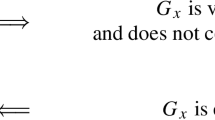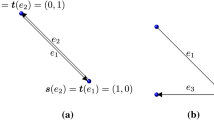Abstract
We describe here several uses of simple continuous-time Markov chains in the study of reaction networks. We describe in particular how the use of a Markov chain can simplify and clarify the analysis of an isomerization network, and how it can identify illegal loops in such a network, that is, cases in which detailed balance is not satisfied. We then describe how ‘additive reversiblization’ can be used to impose (Markov-chain) detailed balance on a network, and provide an example of its use to ‘repair’ an illegal loop identified in the chemical literature.







Similar content being viewed by others
Notes
Or as the author Malcolm Gladwell [9] might call them, igon values.
References
Alberty RA (2004) Principle of detailed balance in kinetics. J Chem Educ 81(8):1206–1209
Stanbury DM, Hoffman D (2019) Systematic application of the principle of detailed balancing to complex homogeneous chemical reaction mechanisms. J Phys Chem A 123(26):5436–5445
Érdi P, Tóth J (1989) Mathematical models of chemical reactions: theory and applications of deterministic and stochastic models. Manchester University Press, Manchester
Érdi P, Lente G (2014) Stochastic chemical kinetics: theory and (mostly) systems biological applications. Springer, Cham
Jia C, Jiang DQ, Li Y (2021) Detailed balance, local detailed balance, and global potential for stochastic chemical reaction networks. Adv Appl Prob 53(3):886–922
Joshi B (2015) A detailed balanced reaction network is sufficient but not necessary for its Markov chain to be detailed balanced. Discret Contin Dyn Syst B 20(4):1077–1105. https://doi.org/10.3934/dcdsb.2015.20.1077
Tóth J, Nagy AL, Papp D (2018) Reaction kinetics: exercises, programs and theorems. Springer, New York
Lente G (2010) The connection between the second law of thermodynamics and the principle of microscopic reversibility. J Math Chem 47(3):1106–1111
Gladwell M (2009) What the dog saw: and other adventures. Little, Brown and Company, New York
Moler C, Van Loan C (2003) Nineteen dubious ways to compute the exponential of a matrix, twenty-five years later. SIAM Rev 45:3–49
Goulet V, Dutang C, Maechler M, Firth D, Shapira M, Stadelmann M (2019) expm: matrix exponential. http://CRAN.R-project.org/package=expm, R package version 0.999-4
Kelly FP (1979) Reversibility and stochastic networks. Wiley, Chichester
Fill JA (1991) Eigenvalue bounds on convergence to stationarity for nonreversible Markov chains, with an application to the exclusion process. Ann Appl Prob 1(1):62–87
Yang J, Bruno WJ, Hlavacek WS, Pearson JE (2006) On imposing detailed balance in complex reaction mechanisms. Biophys J 91(3):1136–1141
Orbán M, Kurin-Csörgei K, Rábai G, Epstein IR (2000) Mechanistic studies of oscillatory copper(II) catalyzed oxidation reactions of sulfur compounds. Chem Eng Sci 55(2):267–273
Colquhoun D, Dowsland KA, Beato M, Plested AJ (2004) How to impose microscopic reversibility in complex reaction mechanisms. Biophys J 86(6):3510–3518
Mitrophanov AY (2004) Reversible Markov chains and spanning trees. Math Scientist 29(2):107–114
Acknowledgements
Dr Alex Mitrophanov is thanked for re-awakening the author’s interest in Markov chains in continuous time. The editor and an anonymous reviewer are thanked for their helpful suggestions, as are Prof. Linda Haines and Dr Etienne Pienaar.
Author information
Authors and Affiliations
Corresponding author
Additional information
Publisher's Note
Springer Nature remains neutral with regard to jurisdictional claims in published maps and institutional affiliations.
Rights and permissions
Springer Nature or its licensor (e.g. a society or other partner) holds exclusive rights to this article under a publishing agreement with the author(s) or other rightsholder(s); author self-archiving of the accepted manuscript version of this article is solely governed by the terms of such publishing agreement and applicable law.
About this article
Cite this article
MacDonald, I.L. Simple examples of continuous-time Markov-chain models for reactions. Reac Kinet Mech Cat 136, 1–11 (2023). https://doi.org/10.1007/s11144-023-02348-5
Received:
Accepted:
Published:
Issue Date:
DOI: https://doi.org/10.1007/s11144-023-02348-5




